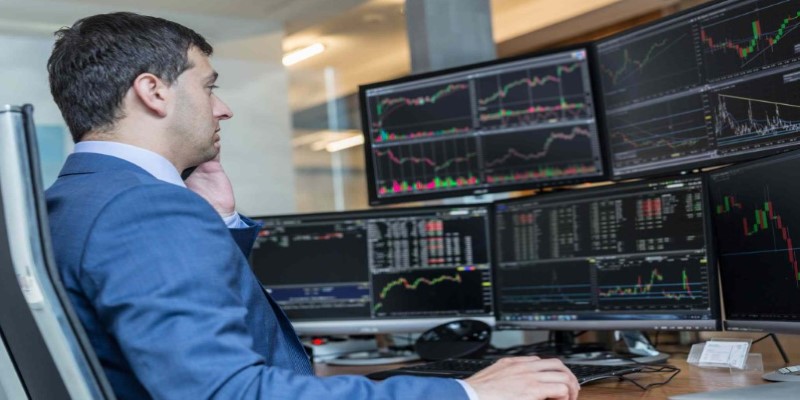Market depth offers a behind-the-scenes look at how a financial market operates, revealing the layers of buy and sell orders that determine an asset's liquidity and price stability. Think of it as a detailed snapshot of the market's ability to handle trades without making drastic price changes.

By delving into market depth, traders can better understand how large orders might influence prices and find optimal entry and exit points. In this article, we'll break down what market depth is, how its used in trading, and walk through a practical example to show its real-world impact.
What Is Market Depth?
Market depth refers to the market's ability to absorb large orders without significantly impacting the price of a financial instrument. It shows the number of buy and sell orders at various price levels in the order book. The order book is a real-time list of all open buy and sell orders for a particular asset, typically organized by price level.
Essentially, market depth gives traders insight into the supply and demand for an asset beyond the current market price. It includes details about the quantity of shares or contracts available at different prices, providing a snapshot of the markets liquidity. The deeper the market, the more orders exist at various price levels, suggesting that the market can handle larger trades without drastic price changes.
How Market Depth Is Used
Market depth provides valuable insights into how a financial market functions, and its applications extend across various aspects of trading and investing. Heres an in-depth look at how market depth is utilized:
Assessing Liquidity
Market depth is a key tool for evaluating an asset's liquidity. Liquidity refers to how easily an asset can be bought or sold without causing a significant impact on its price. By examining the order book, traders can see how many buy and sell orders are placed at different price levels.
A deep market, with numerous orders spread across various prices, indicates high liquidity. This means that large trades can be executed with minimal price movement. For instance, if a trader wants to buy a substantial number of shares, they can check the order book to ensure that there are enough sell orders at the desired price levels to accommodate their purchase without causing the price to spike.
Determining Price Impact
Traders must understand how trade will affect the market prices. Market depth helps predict this impact by showing the current distribution of buy and sell orders. If a trader intends to place a large order, they can analyze the order book to gauge how much they might need to move the price.
For example, if a trader wants to buy a large volume of shares, they will see how much they might need to pay above the current price based on the existing sell orders. Conversely, if they are selling a large amount, they can see how much the price might drop based on the buy orders available.
Identifying Support and Resistance Levels
Market depth helps traders identify potential support and resistance levels. Support refers to a price level where buying interest is strong enough to prevent the price from falling further. Resistance, on the other hand, is where selling interest is sufficient to stop the price from rising.

By examining the concentration of buy orders (support) and sell orders (resistance) in the order book, traders can make informed decisions about where to enter or exit trades. For example, a large cluster of buy orders at a specific price level might suggest that this level could act as a support, while a dense concentration of sell orders might indicate a resistance level.
Strategic Order Placement
Traders often use market depth to strategically place their orders. By analyzing where large numbers of buy or sell orders are concentrated, traders can decide the best price levels to place their own orders. For instance, if a trader notices a large number of sell orders at a certain price, they might place their buy orders slightly below this level to increase the likelihood of their orders being filled.
Similarly, if theres a large concentration of buy orders at a particular price, a trader might decide to sell at a price just above this level to capitalize on the existing demand.
Example of Market Depth
Lets consider an example to illustrate market depth in action. Imagine youre trading shares of a company called XYZ Corp. You look at the market depth for XYZ Corp and see the following information in the order book:
Buy Orders
100 shares at $50.00
200 shares at $49.90
300 shares at $49.80
Sell Orders
150 shares at $50.10
250 shares at $50.20
100 shares at $50.30
This order book data reveals several important insights. If you wanted to buy 100 shares, you would likely get them at $50.00, as there are already 100 shares available at that price. However, if you wanted to buy 300 shares, you would need to purchase the shares at $50.00 and then at progressively higher prices, affecting the market price.
Conversely, if you wanted to sell shares, you would need to accept the current sell prices, starting from $50.10 and moving up if you wanted to sell more than 150 shares. This could push the market price higher, reflecting the depth of the sell orders.
Factors Influencing Market Depth
Several factors influence market depth, affecting how orders are placed and executed. Liquidity is a primary factor; markets with higher liquidity have greater market depth, as more buy and sell orders are available at various price levels. Market Conditions also play a role; during periods of high volatility or economic uncertainty, market depth may fluctuate significantly.

Order Flow reflects the buying and selling activity; increased trading volume typically enhances market depth. Market Participants include institutional investors and retail traders, whose different trading volumes and strategies impact the depth of the market. Understanding these factors helps traders gauge market stability and execute strategies effectively.
Conclusion
Market depth is a vital tool for traders and investors looking to understand the liquidity and price impact of their trades. By examining the order book and observing buy and sell orders at different price levels, market participants can make informed decisions about executing trades and predicting price movements. Whether assessing liquidity, determining price impact, or identifying support and resistance levels, market depth provides valuable insights into the dynamics of financial markets. Understanding how to read and use market depth effectively can enhance trading strategies and improve decision-making in various market conditions.




